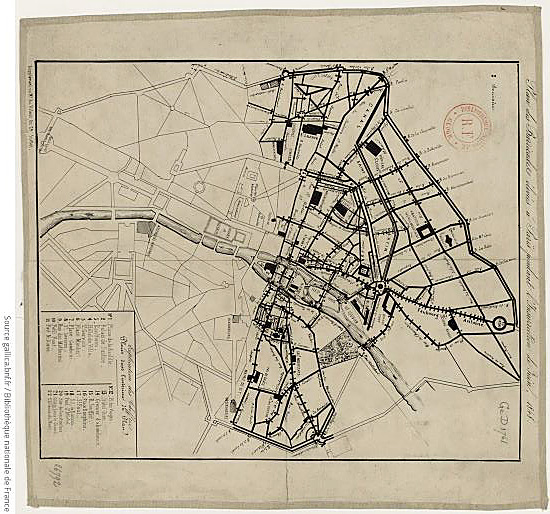I'VE ALREADY DESCRIBED PLACE SAINT-MICHEL, THE PARVIS OF NOTRE-DAME CATHEDRAL AND THE ESPLANADE OF CITY HALL
Now we go east, to places Bastille, République, Nation and Italie, in the heart of the areas where the June barricades arose:
They follow the royal model: They are public spaces toward which straight streets converge, their architecture is homogeneous and a power symbol at their center replaces the the equestrian king.
- Place de la Bastille, created by tearing down the prison that the July Column replaces:
- Place de la République
*Place du Château d'Eau until elections ensconced the Third Republic at the end of the 1870's. The fountain was moved to the 12th.
 |
Zoom |
 |
A gigantic statue celebrates the explicitly conservative republic (since 1883). |
- Place de la Nation, far to the east, a site where the several aspects of the French story take off:
 |
| Zoom |
The original statues on the columns symbolized Justice and Prosperity. The straight street in the background is a symbol of royalty.
April 15, 1792, The First Celebration of Liberty when the Forty Soldiers are Torn Away from the Galleys at Brest / zoom
It was the site of the Revolution's first celebration. In the spring of 1791 soldiers protested noble officers' holding back their pay. Two were hanged and 40 sent to the galleys, to be freed a year later. The fête that followed was a sign of growing egalitarianism.
 |
Execution of the Martyrs of Compiègne at the place of the Overturned-Throne, July 17, 1794 |
Notice the columns in the background.
The guillotine was moved there (in 1794)
Louis-Philippe (1830-1848) tried to reinforce monarchy by replacing the existing statues with those of the most famous medieval kings (Philippe le Bel et Louis IX/Saint Louis).
Overthrown a year later, he is the last king of France.
Visit place de la Nation for its outdoor market and for the royalist shrine and cemetery nearby, which is reserved to descendants of guillotined nobles.
# # #
Besides following the royal model, these majestic places align along the venerable trade route — that is, along the monarchy's Grand Axis.
Except for place d'Italie.
* * *










No comments:
Post a Comment